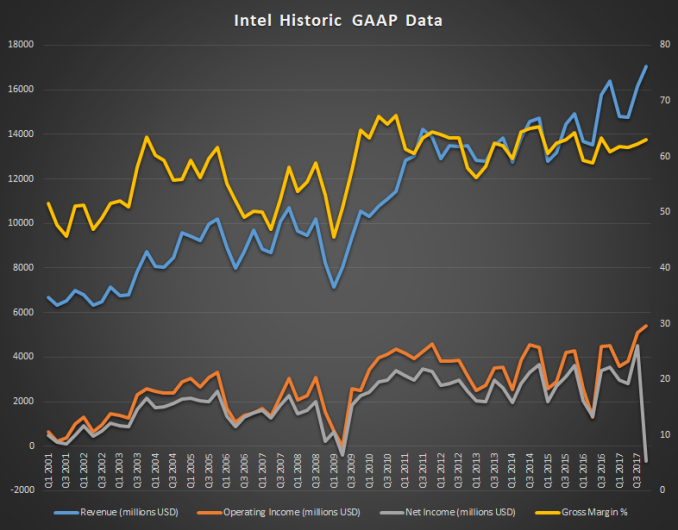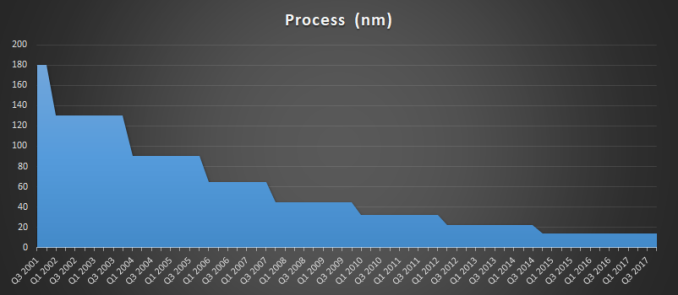Intel Announces Q4 2017 and FY 2017 Results
by Brett Howse on January 25, 2018 10:55 PM EST- Posted in
- CPUs
- Intel
- Financial Results

Today Intel announced their quarterly earnings, and 2017 was another record year for the company. Q4 revenue was a record $17.1 billion, and the full year revenue was a record $62.8 billion. For this quarter, Intel’s GAAP earnings took a hit due to a $5.4 billion tax expense thanks to the new tax reforms that were enacted in December, but as a one-time hit, it shouldn’t be a concern going forward. In fact, Intel is forecasting only a 14% tax rate for FY 2018.
In GAAP terms, Intel’s gross margin was 63.1%, which is up 1.4% from a year ago, and their operating income was up 19% to $5.4 billion. However, thanks to a 111.4% effective tax rate due to the one time $5.4 billion tax fee, Intel is actually reporting a GAAP loss for the quarter of $0.7 billion. Earnings per share were therefore down 120% to a loss per share of $0.15.
Due to the tax impact, it’s probably a good thing to look at Non-GAAP earnings as well which will exclude that one-time charge. In terms of Non-GAAP, Intel’s gross margin was 64.8%, which was up 1.7%. Operating income was up 21% to $5.9 billion. Intel’s Non-GAAP tax rate was 21.2%, which is actually higher than the 19.8% they paid last year, and net income was $5.2 billion, up 34% from a year ago. This led to earnings per share being up 37% to $1.08.
For the full year, Intel had $62.8 billion in revenue, with a gross margin of 62.3%. Operating income was up 39% year-over-year to $17.9 billion, although thanks to the tax hit their net income was down 7% to $9.6 billion. In Non-GAAP terms, net income was up 27% to $16.8 billion.
| Intel Q3 2017 Financial Results (GAAP) | |||||
| Q4'2017 | Q3'2017 | Q4'2016 | |||
| Revenue | $17.1B | $16.1B | $16.4B | ||
| Operating Income | $5.4B | $5.1B | $4.5B | ||
| Net Income | -$0.7B | $4.5B | $3.6B | ||
| Gross Margin | 63.1% | 62.3% | 61.7% | ||
| Client Computing Group Revenue | $9.0B | +1.6% | -2.0% | ||
| Data Center Group Revenue | $5.6B | +14.7% | +20.0% | ||
| Internet of Things Revenue | $879M | +3.5% | +21.0% | ||
| Non-Volatile Memory Solutions Group | $889M | -0.2% | +9.0% | ||
| Programmable Solutions Group | $568M | +21.1% | +35.0% | ||
Intel is still pivoting business away from the declining PC market, and they have done well to diversify, but still, their PC business is still the biggest piece of the pie. For the quarter, the Client Computing Group had revenues of $9.0 billion, which is down 2% year-over-year, but for the full year of 2017, their CCG was up 3% to $34 billion. It’s not quite dead yet. In an effort to show their diversification, Intel is now quoting their data in “PC-centric” and “Data-centric” and conveniently, Data-centric is all of their business outside of the CCG, but even so, the CCG still accounted for 53% of Intel’s revenue for the quarter.
But, the Data-centric group is certainly growing much quicker than the PC market which is still in a decline. The Data Center Group is by far the largest portion of Intel’s Data-centric efforts, and the DCG had revenues of $5.6 billion for the quarter, which are up 20% year-over-year. With the expansion of the cloud, this likely still has some ways to go before it hits a peak, so it’s likely just a matter of time before they finally surpass their Client Computing Group.
The rest of the Data-centric business was also up for the quarter, with IoT up 20% year-over-year, to $879 million. For the full year the IoT was up 20% and had revenues of $3.2 billion. Non-volatile memory was up 9% for the quarter to $889 million, and for the year it was up 37% to $3.5 billion. Programmable Solutions was up 35% for the quarter to $568 million, and for the full year, was up 14% to $1.9 billion.
Intel still hasn’t shipped anything on 10nm to the point where someone could go buy a chip, although we’re finally getting close, with Intel shipping 10nm to some of their partners. 14nm was delayed, but the delay in getting to 10nm has been longer than likely anyone expected. Intel has still made some bold claims about density, so it should be a good node for them if and when it arrives.
Intel’s forecast for Q1 2018 is for $15.0 billion in revenue, plus or minus $500 million, and despite the rough start to 2018, they are still forecasting another record year, with $65 billion in revenue, plus or minus $1.0 billion.
Source: Intel Investor Relations












42 Comments
View All Comments
krumme - Friday, January 26, 2018 - link
Money machineLord of the Bored - Friday, January 26, 2018 - link
I love that Intel is sitting here trying so hard to diversify after spending so long doing the exact opposite. They used to BE a diverse semiconductor company before they dumped everything to focus on processors to the exclusion of all else.Oh well, I guess a couple decades as "just" the biggest processor manufacturer on Earth was a fair trade.
Klimax - Friday, January 26, 2018 - link
Interestingly, same process was seen with AMD in early 00s.Strunf - Friday, January 26, 2018 - link
True but at the end of the day they did chose the best option, all that diversity was costing money so by cutting them down Intel increased profits and now that CPUs are "has been" they can start shopping for talent and even up and coming companies, with the massive stock pile of money they got from all those years of being a CPU company it shouldn't be too difficult to stay relevant and their fabs can be tuned to build other microchips.boozed - Friday, January 26, 2018 - link
So... how much money did Intel make selling CPUs that don't contain massive security flaws?Klimax - Friday, January 26, 2018 - link
And how much AMD?WorldWithoutMadness - Friday, January 26, 2018 - link
**Grab tin foil hat**What if this is all planned tor the sake of surveillance?
They gain money from sales and on top of that being paid for this flaw
iwod - Friday, January 26, 2018 - link
The Meltdown and Spectre are too recent of an event to make an Impact. We should know in Q1 2018.Another point worth discussing, AMD is selling as many EPYC as they could, Ryzen is also selling well or sold out. Which means, the PC market isn't really shrinking, it is actually stabilizing. And as long as Tablet aren't actually replacing PC, ( Which it isn't yet ), PC is safe for now, with Gaming fueling its possible future growth.
And for the DC market, despite AMD selling lots, Intel still finds huge area for growth, as if there are no limit.
HStewart - Friday, January 26, 2018 - link
"Another point worth discussing, AMD is selling as many EPYC as they could, Ryzen is also selling well or sold out. Which means, the PC market isn't really shrinking, it is actually stabilizing. And as long as Tablet aren't actually replacing PC, ( Which it isn't yet ), PC is safe for now, with Gaming fueling its possible future growth."PC Market is actually involving in more Mobile areas and less on desktop. Tablets are small part of Mobile Laptop market but are grown. Most Ryzen sales come from desktops with build of game machines and people purchase chips on Amazon and Newegg and those numbers are not good numbers to based the market.
PC Market is not really shrinking, but desktop PC Market is shrinking.
For AMD a small growth would be consider a big - but in Intel terms that growth is nothing.
Meltdown and Spectre - also effects AMD and ARM - but I don't believe most people care.
Samus - Saturday, January 27, 2018 - link
Nobody buys EPYC for the desktop dude. And AMD CPU’s are immune to meltdown. All of them. Server, workstation, desktop, or mobile.